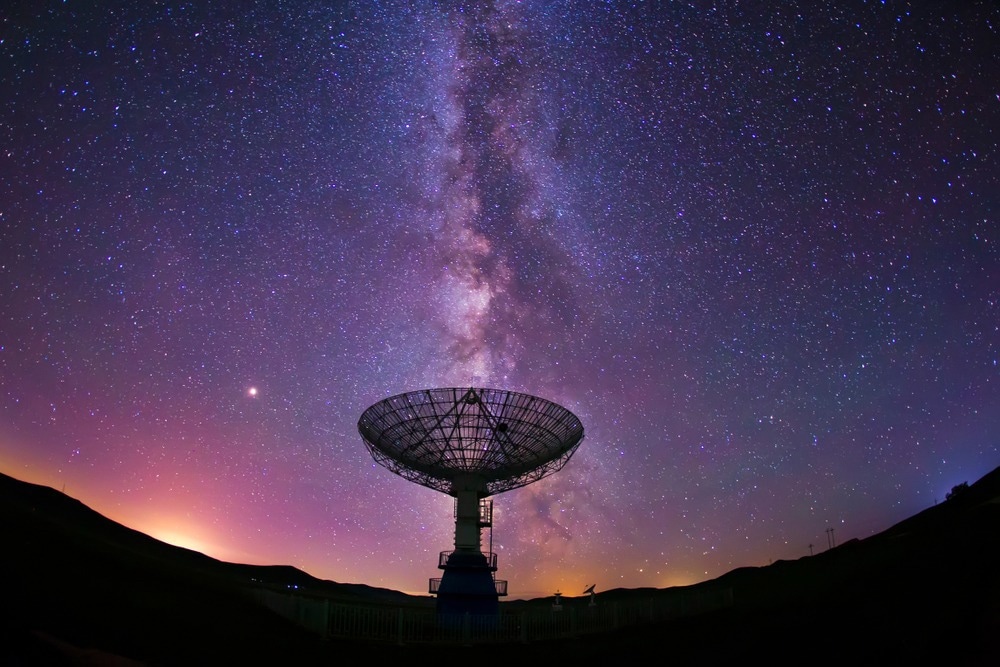US President Joe Biden unveiled the first images from the James Webb Space Telescope (JWST) in July 2022. The joint NASA, ESA, and CSA mission is building on the success of previous space telescopes – notably, the Hubble Telescope – to provide the most detailed and captivating look at our universe.

Image Credit: zhengzaishuru/Shutterstock.com
The first full-color images from Webb showed thousands of galaxies and some of the faintest objects ever observed in infrared light.
As the first “deep field” images from Webb were presented to the global public, NASA administrator Bill Nelson said:
Webb's First Deep Field is not only the first full-color image from the James Webb Space Telescope, it’s the deepest and sharpest infrared image of the distant universe, so far. This image covers a patch of sky approximately the size of a grain of sand held at arm’s length. It’s just a tiny sliver of the vast universe.
These images' unprecedented depth and detail result from a culmination of achievements in diverse fields. But the Webb is far from the first space telescope to beam spectacular images of our universe back to Earth.
What are Space Telescopes?
Space telescopes (and their sister structures, space observatories) were first suggested in 1946 by an American astronomer and theoretical physicist Lyman Spitzer, but it was over two decades before the first operational telescopes were launched into space.
The United States’ American Orbiting Astronomical Observatory (OAO-2) was first in 1968, with the Soviet Union’s Orion 1 ultraviolet telescope following it out of the atmosphere three years later on the space station Salyut 1.
Space telescopes are specially designed spacecraft that carry sensors into space, sometimes in orbit around Earth and now – with the Webb – around the sun. Various types of space telescopes exist, collecting data on different wavelengths of electromagnetic radiation (light, at some wavelengths).
Some space telescopes map the entire sky at a specific resolution for astronomical surveys. Others can be pointed toward areas of interest. These are often available for astronomers to use on an application basis, similar to submitting a research proposal.
Most space telescopes currently in operation are in a distant orbit around Earth, far enough away to avoid Earth’s atmospheric effects but close enough to reliably transmit data back to ground operations.
However, the Webb is actually in orbit around the sun – much further away than any other space telescope launched. Its orbit is configured to closely follow Earth’s orbit, so that data transfer is still possible.
Why Do Astronomers Put Telescopes in Space?
One of the significant advantages that all space telescopes have offered is the ability to sense electromagnetic radiation away from the filtering and distorting effects of Earth’s atmosphere and light pollution.
From Earth, stars appear to “twinkle” in the night sky, emitting a flickering and non-uniform light. This phenomenon, scientifically known as scintillation, is caused by Earth’s atmosphere, which distorts the visible light (and other wavelengths of radiation) as it passes through it.
All Earth-based telescopes are confronted with the scintillation problem. Some of the largest terrestrial telescopes can use adaptive optics to reduce the effect, but it can only be eliminated entirely by placing a telescope in space.
This means that space telescopes can have a larger angular resolution than terrestrial telescopes, even with the same aperture.
The effect of scintillation is noticeable in visible light and with the naked eye, but space telescopes are at their most effective when detecting frequency ranges outside both optical and radio wavelengths.
Optical and radio astronomy are at least possible from Earth-based telescopes. X-ray astronomy, on the other hand, is more or less impossible with terrestrial telescopes due to scintillation effects. Infrared and ultraviolet astronomy can also only be done effectively from space.
Difficulties Sending Telescopes to Space
Alongside these significant advantages, there are major challenges to space-based astronomy.
It is much more expensive to build telescopes for space. They need to be ruggedized, they need to be able to transmit data back to Earth, and they need to make it out of the atmosphere in the first place.
Engineers have to work very hard to minimize weight, shaving grams off every component and device on board wherever possible. These harsh demands have to be balanced with operational requirements for precision and accuracy – space telescopes are also research-grade astronomy instruments that must be able to provide reliable data.
As well as the difficulties designing and launching space telescopes in the first place, their position outside Earth’s atmosphere makes them incredibly difficult to maintain.
When the Hubble Space Telescope launched, its sensors were miscalibrated, essentially putting the telescope out of focus. Astronauts on the Space Shuttle could go directly to the telescope and fix it, but this is not possible with the Webb due to being outside Earth’s orbit.
This means that space-based astronomy needs to be a collective human effort, and the success of the Webb launch and its stunning first images prove that this kind of effort can reap wonderful rewards for humanity.
Continue Reading: The World's Largest Robotic Telescope and the Future of Space Exploration
References and Further Reading
NASA (2022). NASA Reveals Webb Telescope’s First Images of Unseen Universe. [Online] NASA. Available at: https://www.nasa.gov/press-release/nasa-reveals-webb-telescope-s-first-images-of-unseen-universe (Accessed on 22 July 2022).
NASA (2022). President Biden Reveals First Image from NASA’s Webb Telescope. [Online] NASA. Available at: https://www.nasa.gov/press-release/president-biden-reveals-first-image-from-nasa-s-webb-telescope (Accessed on 22 July 2022).
Thompson, A. (2009). Major Space Telescopes. [Online] Space.com. Available at: https://www.space.com/6716-major-space-telescopes.html (Accessed on 22 July 2022).
Disclaimer: The views expressed here are those of the author expressed in their private capacity and do not necessarily represent the views of AZoM.com Limited T/A AZoNetwork the owner and operator of this website. This disclaimer forms part of the Terms and conditions of use of this website.